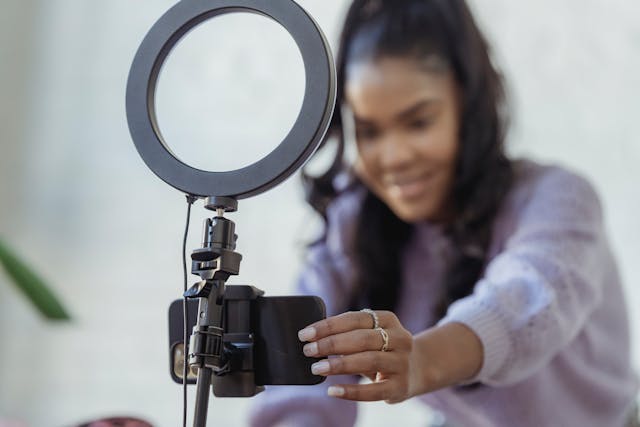Nano vs Micro Influencer: How Are They Different?
Social media influencers are here to stay. However, there are different kinds of influencers. Many want to know the difference between the nano vs micro influencer.
The difference between nano and micro-influencers mainly lies in the number of followers they have.
Nano influencers are everyday social media users with 100 to 10,000 followers. On the other hand, micro-influencers usually have 10,000 to 100,000 followers. Read on as we unpack more ways to differentiate the two types.

What Are the Types of Influencers?
The types of influencers include nano, micro, macro, and mega influencers. These influencers differ based on their number of followers.
Follower count matters in this aspect because it defines influence and popularity. So, here are the different types to consider.
1. Nano Influencers
Nano influencers are regular social media users. They usually have 100 to 10,000 followers and are not necessarily professional influencers.
Most of their posts typically contain memes and photos of themselves with family, friends, pets, etc. However, they can also share other types of posts.
These influencers do not usually have crazy levels of engagement since they only have a few hundred or thousand followers. They are much more common in the influencer ecosystem.
Despite not having many followers on their social media profiles, nano influencers usually have some influence within their communities. These could be people who influence their local neighborhoods or organizations.
For instance, local pastors, community leaders, and local government leaders all fall into this category.
Of course, even these influencers can recommend products and services to their families and friends. They usually use user-generated content (UGC) for this purpose.
2. Micro-Influencers
Usually, micro influencers have between 10,000 and 100,000 followers. These influencers generally focus on specific niches or areas. Therefore, they are usually specialists or experts in those areas.
Generally, micro influencers have stronger relationships with their audiences than their mega and macro counterparts. This is because their audiences perceive them as subject-matter experts in their fields.
Unlike regular influencers, these influencers attract a very uniform audience.
Tech companies, stock trading firms, and others engage micro influencers in their influencer marketing campaigns. Although you wouldn’t consider them celebrities, they have quite a reliable audience.
3. Macro Influencers
Macro influencers are one step down from mega influencers. They usually have between 100,000 and a million followers. These influencers fall between the micro and mega categories and are similar.
Unlike many mega influencers, most macro influencers became famous online. They may have gained fame from vlogging or creating fun and inspiring content. They are a valid option if you’re targeting a broader demographic.
4. Mega Influencers
Mega influencers are at the top of the influencer ecosystem. They usually have more than a million followers and are more famous and more influential. Their followers are quite diverse, containing people with different interests.
The relationships between mega influencers and their audience are more distant. They are not necessarily experts in a specific subject. However, they are usually famous due to their external activities. Celebrity influencers, including A-list and B-list celebrities, fall within this category.

Settling the Nano vs Micro Influencer Discussion
Many social media experts have weighed in on the micro-influencer vs nano influencer topic. While their difference lies in their follower counts, there are other differences. For instance, they interact with their followers differently.
So, here are some of the differences:
1. Micro Influencers Usually Have More Followers
Generally, micro influencers have a larger audience than their nano counterparts. While nano influencers have between a hundred and 10,000 followers, micro influencers have 10,000 to 100,000. So, a brand may favor the latter for their influencer campaign.
This difference in follower counts is due to their roles on those social media platforms. Nano influencers primarily create content for family, friends, and members of their community. On the other hand, micro-influencers address a much larger audience.
2. Unlike Nano Influencers, Micro-Influencers Are Usually Experts
Typically, micro influencers have subject-matter knowledge of their specific fields, unlike their nano comrades. Because of this, they attract a larger, pretty homogeneous audience. This is a significant aspect of the nano influencer vs micro influencer differential.
This means their followers comprise people with specific interests in particular topics and fields. These followers usually consider such influencers as authorities in their fields. So they are more likely to listen to them on topics and ideas relating to that area.
3. Nano Influencers Interact With Their Followers More
Regarding their relationships with their followers, nano influencers interact more with their audience than their micro allies. Since the former mostly know their followers outside social media, they can better influence them.
For example, influencers can better convince friends and family to buy a brand’s product or service. However, most people would instead go with industry experts when it comes to professional advice. This is the effect of this closeness that brands look for when hiring one.
4. Micro Influencers Attract More Engagement Than Nano Influencers
Due to the disparity in followers, micro influencers generally attract more engagement to their posts. Of course, their posts reach more people on these social media platforms, prompting more likes, replies, shares, and reposts. This is another point in the discussion on nano influencers vs micro influencers.
Due to their higher number of followers, their engagement rates may not align with those of nano influencers. A lower number of followers balances these rates even when there are lower levels of engagement. Again, brands must consider their aims and targets when choosing which influencer to work with.

The Impact of Micro-Influencers
You must choose the right candidate when running an influencer campaign or using an influencer marketing strategy. However, several factors come into play here.
First, you must understand an influencer’s impact. But how impactful can micro-influencers be?
Unlike mega and macro influencers, micro influencers attract niche audiences and build connections with them. While they do not reach as many people, they strongly impact these audiences. As a result, micro influencers are efficient in brand promotions.
But that is not the only reason. Experts have noted that micro-influencers usually have more credibility among their audiences. Their recommendations go a long way since their followers view them as experts in certain areas. This perceived credibility can significantly affect the effectiveness of a marketing campaign.
For instance, consider a micro-influencer who is an expert cryptocurrency trader. If that influencer recommends a specific crypto exchange platform, their followers are likelier to go for it. Or if the influencer tips their followers about a specific cryptocurrency project, followers will more likely invest in that project.
Compare this with a famous football player with tens of millions of followers recommending a crypto project. Of course, followers will be much more skeptical about their recommendations since they are not experts in the field.
Transparency is another important factor that comes into play when considering micro-influencers impact. Naturally, it is way easier to hold these influencers accountable. Since they understand this, they are usually more transparent with their audiences.
All these factors foster their impact on brand influence. Still, the type of influencer to work with depends significantly on what the brand needs.
Are Nano Influencers Worth It?
Nano influencers may be worth the hire if you’re targeting the smaller group that forms their audience. While they usually have a smaller audience and less engagement, there are some advantages to working with them.
However, their limited influence and reach sometimes prompt doubts about whether nano influencers are worth it.
Many big and medium brands are now working with nano influencers because of their regular-guy persona. The “everyday people” image they portray appeals better to some audiences. Since these brands understand this, they can exploit this response.
These influencers are quite valuable if you’re looking to trigger such responses. They also charge less than others. So, in the end, the influencer you work with depends on your strategy.

Grow Your TikTok Followers and Influence With High Social
Are you trying to grow your followers and influence to become an influencer on TikTok? Instead of sweating about it, hire High Social to do the job for you.
This TikTok growth service helps you attract organic followers who will engage with your content.
The service operates simply. Log into the site and describe the type of followers you need based on age, demographic, gender, and location. The agency will then promote your content to your target audience. Those that find your content appealing will follow your profile.
Without hiring a nano vs micro influencer, you’ll get followers with specific interests in your type of content.
So, if you’re looking for that audience to boost your presence on TikTok, go with High Social. Its advanced targeting techniques attract only the choicest followers. Start your TikTok growth now!













